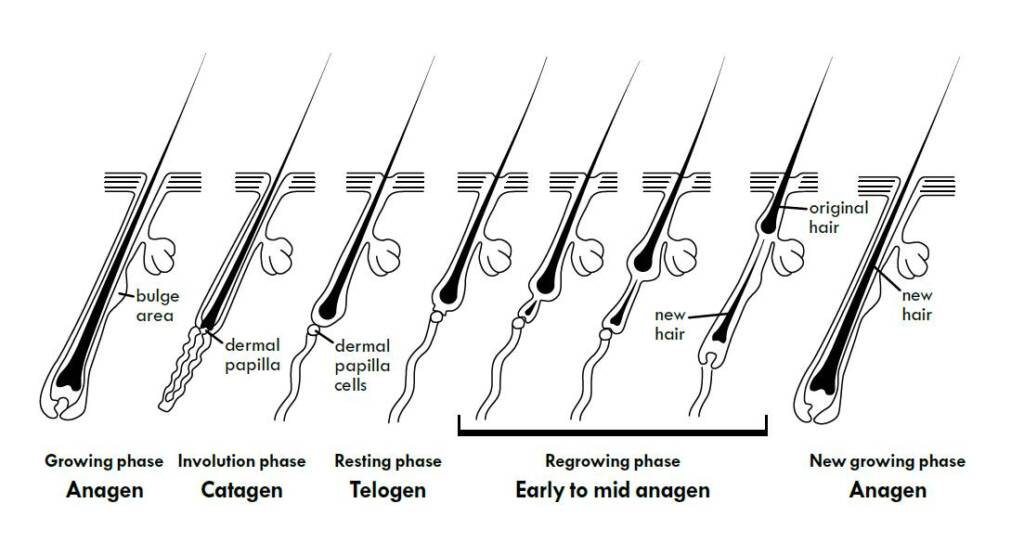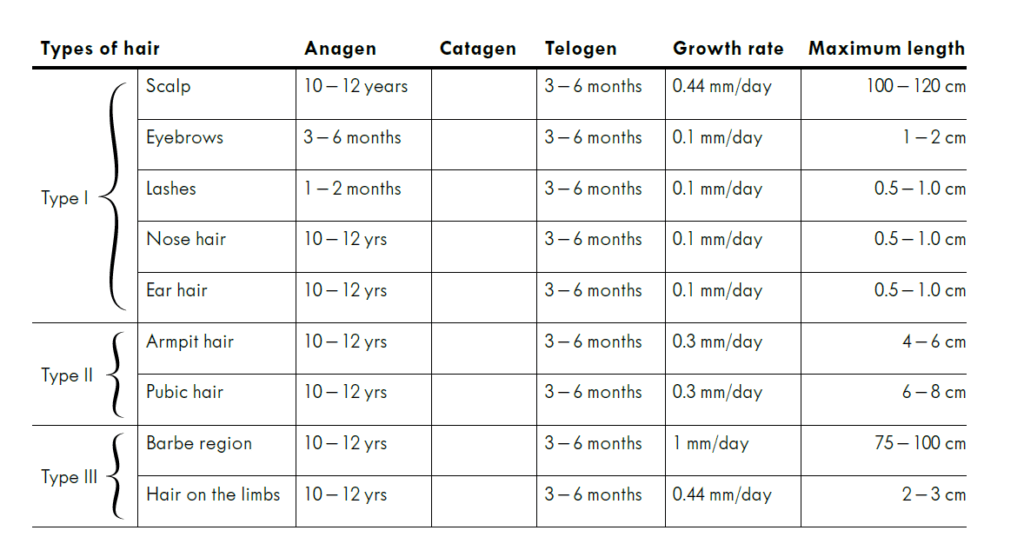Women often get alarmed when they suddenly start losing more hair than usual. However, hair loss in women is not necessarily a cause for panic. It’s often temporary, and even if the hair loss is more permanent, there are usually solutions available.
Hair Growth Cycle
Let’s start from the beginning: How does normal hair growth in women work? It occurs in cycles, with hair growth phases that are repeated continuously. The anagen phase, also known as the growth phase, is when new hair growth occurs. On average, hair grows about 1.25 cm per month, and approximately 90% of your hair is in this phase. This phase lasts around three to five years, and in some cases, even longer. For eyebrows and eyelashes, this phase is much shorter.
Transition Phase
The catagen phase is the transition phase that marks the end of the growth phase. During this stage, the hair follicle retracts and detaches from the hypodermis (where it gets its nutrients). The hair root disappears, and the root end forms a club-like shape. This phase lasts for one to two weeks, and only about 1% of your hair is in this stage at any given time.
Resting Phase
The telogen phase is known as the resting phase of the hair and is the final stage of the hair growth cycle. The telogen phase lasts as long as the mature hair needs before falling out. Hair in the telogen phase will typically fall out during this period, though it can also be pushed out by a new hair in the anagen phase. About 10% of your hair is in the telogen phase, which typically lasts three to six months.

Repeat
When the telogen phase ends, a new anagen phase begins in the hair follicle. The entire hair growth cycle, consisting of all three phases, repeats itself on average every three to five years.
Excessive Hair Loss?
On average, a person loses about 50-120 hairs per day. This is normal, and most people don’t notice it. However, if you start losing more hair than usual or if your hair becomes noticeably thinner, the hair growth process may be disrupted, leading to excessive hair loss. Although this issue is common, the underlying causes can vary. The most common cause of excessive hair loss is hereditary baldness (androgenetic alopecia or AGA), which affects both men and women.
DHT Shortens the Growth Phase
Androgenetic alopecia occurs because hair follicles are sensitive to the hormone dihydrotestosterone (DHT). The sensitivity of the hair follicles to DHT is inherited in both men and women. DHT weakens the hair follicles and shortens the hair’s growth phase from three to five years down to just a few months. After each growth phase, the new hair that grows from the follicle becomes thinner (miniaturization) until the follicle eventually dies and no longer produces hair.
Hereditary Baldness in Women
Forty percent of all women experience hereditary hair loss at some point in their lives. Fifteen percent of women experience it before menopause, sometimes at a very young age. Approximately three to six percent of women under thirty suffer from hereditary hair loss. By the age of seventy, almost every woman has a less full head of hair.
Unlike men, hereditary hair loss in women tends to occur evenly across the scalp. Hair becomes significantly thinner, starting from the crown and spreading across the scalp, which can eventually lead to permanent baldness.
Other Causes
Besides hereditary baldness, there are many other causes of (temporary) hair loss in women. Hormonal changes (pregnancy), iron deficiency, dieting, stress, or underlying medical conditions can all contribute. External factors, such as frequent hair coloring or tightly binding the hair, can also lead to hair loss. There are many other possible causes to consider as well.
Telogen Effluvium
A common cause of hair loss in women is telogen effluvium, where stress or physical changes trigger hair loss. In this condition, the normal hair growth cycle is interrupted. Many hairs suddenly stop growing, entering the transition phase and then the resting (telogen) phase. After about four months in the telogen phase, these hairs fall out all at once.

Acute Telogen Hair Loss
There are two forms of telogen hair loss: acute and chronic. Acute telogen hair loss often occurs due to a sudden or severe physical change, such as childbirth, a serious illness (like cancer), a period of drastically reduced food intake, anesthesia, stress, or fever.
Chronic Telogen Hair Loss
If the hair loss lasts longer than six months, it is referred to as chronic telogen hair loss. The most common causes of chronic telogen hair loss include thyroid disorders, anemia, certain medications (such as blood thinners, acid reducers, painkillers, beta-blockers, and chemotherapy), excessive vitamin A intake, and diseases affecting the pancreas, liver, or kidneys.
The Impact of Stress
Psychological stress can trigger telogen hair loss. High levels of stress hormones like cortisol and adrenaline prepare the body for action by mobilizing energy through fat burning and protein production. However, staying in this heightened “state of readiness” for too long is harmful. Prolonged high cortisol levels are not only bad for the body but also for hair, as hair follicles can stop growing or slow down their growth in response to stress.
Hair Loss After a Stressful Event
Hair loss is often noticeable three to four months after a stressful event, sometimes occurring in clumps. Once the stress subsides, hair growth usually recovers over eight to twelve months, although in some cases, the hair loss may last longer. If you’re genetically predisposed to hair loss, stress can exacerbate the problem.
Hair Loss During Menopause
Age-related hair loss often begins during menopause due to hormonal changes. During this time, estrogen and progesterone levels decrease, leading to a relatively higher testosterone level. Age-related hair loss is influenced by the same factors that cause graying hair.
Genetically Predisposed Sensitivity
As part of the aging process, hair not only becomes thinner but also fewer hairs grow from each follicle. This process is influenced by hereditary and hormonal factors, particularly the genetic sensitivity to the hormone dihydrotestosterone (DHT).
Alopecia Areata or Patchy Hair Loss
Alopecia areata is a condition that affects the hair roots in certain areas of the skin, resulting in round bald patches. These patches typically occur on the scalp but can also appear on other parts of the body, such as in the beard area of men. In most cases, hair growth resumes naturally within a few months to years.
Cause unknown
In some cases, the hair does not come back or new bald patches keep appearing. When the body hair disappears completely, we talk about alopecia universalis. Alopecia areata is an autoimmune disease with an unknown cause.
Frontal fibrosing alopecia
Frontal fibrosing alopecia (FFA) occurs almost exclusively in postmenopausal women over the age of 50. This form of hair loss involves a localised form of baldness at the anterior hairline, often accompanied by scarring.
Possible causes
Exactly how FFA develops is not yet known. It is thought to be an autoimmune reaction, but in addition, it is linked to the use of synthetic UV filters, such as oxybenzone, found in sunscreens. Frontal fibrosing alopecia also seems to be related to the condition lichen planus: an inflammatory disease in which the (head) skin is affected.
External factors
This form of hair loss in women results from external factors with a damaging (traumatic) effect on the hair follicles. Consider factors such as perming, dyeing or tying the hair too tightly. This damages the hair and causes it to break off more quickly. The broken-off hairs can then fall out, resulting in proportionally more hairs falling out than growing in.
Hair loss with cancer
Hair loss is one of the best-known side effects of cancer treatment. This form of hair loss is almost always temporary. Nevertheless, it is very difficult for many women when they lose their hair. Not every woman who receives chemotherapy or radiotherapy will lose her hair. It depends, among other things, on your treatment (radiation and/or chemo), the dosage and type of medication and any additional medication.
Usually hair grows back
After finishing chemotherapy, hair usually grows back on its own. However, many people do experience that their hair has a somewhat different texture than before the treatments.
Measuring hair loss
If hair loss is visible to the naked eye, it means that half of the hair has already disappeared. Sometimes this has then been going on for years. This is why early recognition is important.
Wastest
You can test hair loss yourself with, for instance, the washout test: wash your hair over a closed sink every day for a week, collect the hairs from the sink, jug or brush and place them on a tissue. Count the hairs. If >100 hairs are lost per day, excessive hair loss is present.
Picking or pulling test
Another test is the pluck or pull test: do not wash your hair one day before the test. Count a tuft of 60 hairs on the scalp and hold it in one tuft. Gently pull the tuft of hair. Do up to 6 hairs (=10%) come loose? This is normal. Repeat the test in different places. It is also possible to have a hair measurement with a so-called trichoscope done by a doctor.
Hair loss in women: no immediate cause for panic
Fortunately, hair loss in women can often be treated. There are all kinds of treatments and procedures that can be used, such as a Hair Stem Cell Transplant (HST). When dealing with hair loss, the first step is always to consult a medical doctor. After all, the treatment of hair loss depends on the cause of the hair loss.
Book a free-consultation



